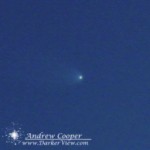Astrophotography is not normally a daytime activity, but there are exceptions. If a comet is bright enough, about magnitude -2 or brighter, it is possible to spot the comet in the middle of the day. Comet C/2012 S1 ISON may very well be visible near the Sun in the middle of the day.

This sort of solar intensity will cause the comet to emit enormous amounts of gas and dust. It is this cloud of material around the comet, the coma and tail, reflecting the sunlight that makes the comet bright.
A few factors can assist in observing a daytime comet… Good knowledge of where to look, where in relation to the Sun will the comet be located. Good clear skies, free of haze or dust that can obscure the view.
Where to look can be calculated with a planetarium program. A few taps on the screen and you will know right where to look. Estimating the distance from the Sun can be done using your hand for reference.

In January 2007 I photographed comet C/2006 P1 McNaught about 5° from the Sun in the middle of the day. I used a small 76mm refractor placed just inside the shadow of my carport. As the comet was east of the Sun the shadow only got deeper as the Sun moved across the sky. Unfortunately ISON will be to the west of the Sun prior to perihelion, thus the same trick will not work. After perihelion comet ISON will be north of the Sun and something similar should work.
In June 2012 the target was Venus as it neared transit. I managed a photograph while the planet was a little over 12° from the Sun. This was done by aiming the telescope at the Sun, with an appropriate filter. Using the coordinates of the Sun I then offset to the correct location for Venus and removed the filter. It worked, but I hesitate to use this technique much closer to the Sun than about eight or ten degrees.
It does not even take a telescope to get the shot. In December 2012 I managed a shot of C/2011 W3 Lovejoy in broad daylight using nothing more than my DSLR and a standard lens. Using the clear skies of Mauna Kea I placed the Sun just behind the Keck 1 dome and fired away. I knew the comet was 4° west of the Sun and just shot the appropriate patch of sky. This was a much tougher target than McNaught had been and required processing to reveal the comet, but it worked.
I look forward to photographing comet ISON near the Sun at perihelion. With any luck it will be brighter than comet McNaught, easily visible to the unaided eye in the middle of the day.

